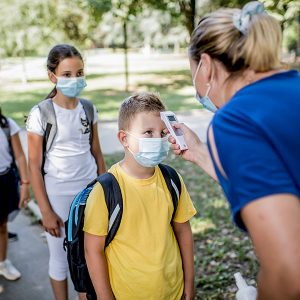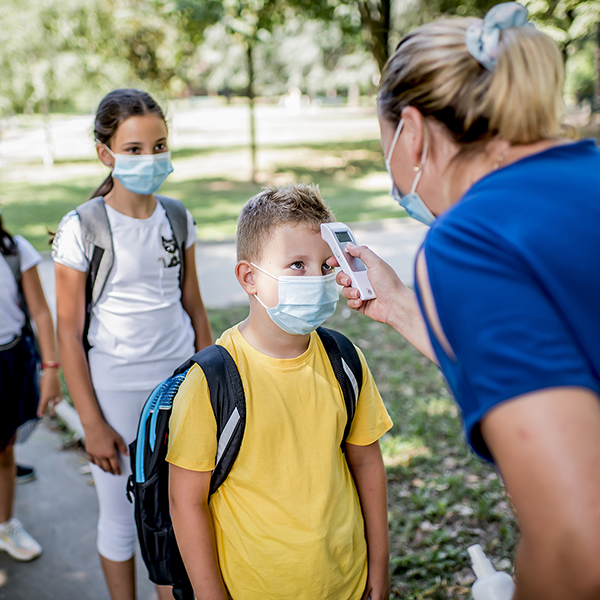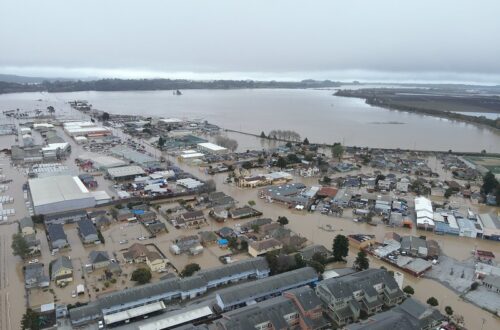How the Office of Education Fights an Invisible Invader
By Suki Wessling

 Jennifer Buesing is a mom who really hopes that her two kids can go back to school soon.
Jennifer Buesing is a mom who really hopes that her two kids can go back to school soon.
She’s also one of the people in charge of deciding when that will happen.
“Things always seem easier on paper,” admits Buesing, Director of School Safety for Santa Cruz County Office of Education (COE). “You think you have a great plan, but until you actually go to the school and you walk through your day, then we realize that we have some pieces to work out.”
Until March of this year, Buesing had a very different job.
“All of the schools were prepared for a critical incident,” she remembers. “All of our teachers and students were prepared [with] a good safety plan: active shooter trainings, prevention work.”
“And then Covid came.”
One statistic stands out when looking at how quickly the definition of ‘school safety’ changed: March was the first month without a school shooting in the US since 2002. The most feared visitor to a school campus is now an invisible virus.
School safety in the era of Covid
Buesing uses the word ‘pivot’ a lot when speaking about what it’s been like to work on safety in our schools since March.
“Since Covid came I have taken on the liaison position with our health providers,” Buesing explains. “A lot of focus is on children’s social and emotional health during distance learning. We’re trying to make sure that we can reach all of our students either who were at risk before or who are at risk now.”
The COE’s first pivot was when the ‘temporary’ school closure in March became longer-term and then extended through the end of the school year. Plans were made and then revised. Eventually, once schools were declared closed through the rest of the school year, they could focus on fall. The COE and districts had to put together plans for three possibilities for fall: full distance learning, a hybrid model, or full-time in-person learning. Three plans for each school and for each program within those schools.
It was a lot to process.
“We’ve been really getting good as a community at pivoting,” Buesing says. “At the SCCOE, we put together a framework for reopening for all schools—public, private, and charter. We had a team of people and we would go to each school with our checklist to see what the plan is, and of course our three different options. Then we’d provide feedback and necessary changes.”
As her team ‘walked through’ a typical day at each school, they were faced with mountains of details to sort through. Multiple entrances to one school would be logistically difficult, so they had to choose one entrance and figure out how to close off the others. They had to look at how children were arriving at school—walking, in private cars, or in busses. Parents of new kindergarteners would have to drop them at the entrance rather than walking them in, as is typical.
They had to look at the accessibility of hand-washing facilities and supplies. They had to look at each and every classroom to see how many children could be seated safely for in-person instruction.
With desks facing forward and six feet apart, “Class sizes will have to be smaller, which is a tricky piece. At the same time that this is happening the state has requested that all school districts reduce their budget. It would be great if we could hire a lot more staff and teachers, but instead we have to be very creative about how it is going to work.”
The crystal ball: back to school for some
Buesing says that now that Santa Cruz County is in the state’s “red” zone, many schools have already started one-on-one and small group instruction for at-risk students. Those students may be struggling emotionally, living in unsafe conditions, or unable to access the Internet for distance learning.
“We’re going to start small and see if we can do it in a safe manner for our students and teachers and the community,” Buesing explains. “We’re dealing with small groups, baby steps first, working out all the kinks, then it will be easier for us to open for full in-person instruction.”
A big piece of the puzzle recently fell into place when the county reached an agreement with Stanford Labs to provide the surveillance testing required by state law. All staff will be tested at least every two months, and anytime on demand.
But there’s still planning to do as the programs ramp up. For example, what will each school do if a child gets sick during the school day?
“We don’t want to send a sick kid to just sit in the front office,” Buesing says. “There needs to be a concrete plan for who would be the person with an increased level of personal protective equipment.”
Buesing says that her own children ask her and she answers that she doesn’t have a crystal ball. “What I have told my children is when they’re having a hard time with distance learning, my estimate might realistically be after the holidays.”
But she admits that even then, many families might not be ready to send their students back. The county will most certainly finish out this school year with a mix of in-person, hybrid, and distance learning.
Plenty to do right now
In the meantime, Buesing says that even though campus violence is no longer a huge issue in her daily work, students are keeping her plenty busy. First of all, because teachers are not trained to work with students at a distance, safety training has taken on a new look.
“There is training specific on recognition for signs of abuse or trauma, neglect, what it might look like, ways to report it.”
And even though students are not in school, the schools are still looking out for their emotional health.
“The students are not engaging academically as perhaps we’d like, but the bigger focus is being able to connect with them on an emotional and a social level,” she explains. “My concern is when we’re on the other side of Covid, what is it going to look like for our students? If they weren’t getting support at home, school was a place for them where they could get support.”
As for Jennifer Buesing herself, at the end of a long day of trying to keep all the students in Santa Cruz County safe, she takes refuge in baking.
“Maybe it’s not the healthiest thing,” she admits.
But like all of us, the people working to keep our community’s kids safe and well-educated are doing what they can to pivot, over and over again, as Covid demands new ideas and flexibility.
Podcast! Interested in hearing the full conversation? Check out our podcast of this interview at tinyurl.com/GUISCPivot2020.
Suki Wessling is a local writer and teacher and the mother of two college students. Read more at SukiWessling.com.







